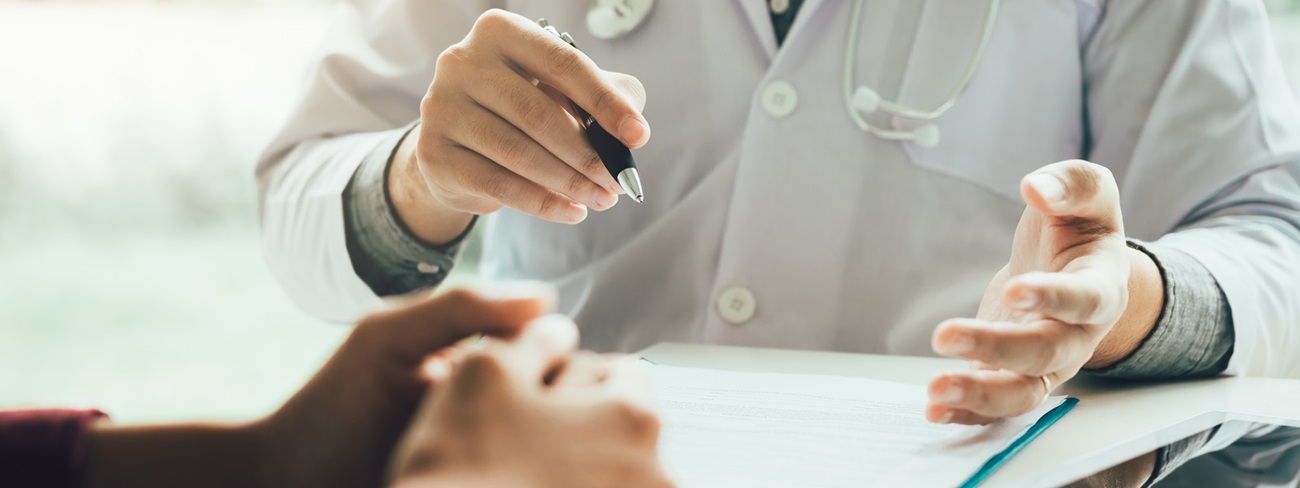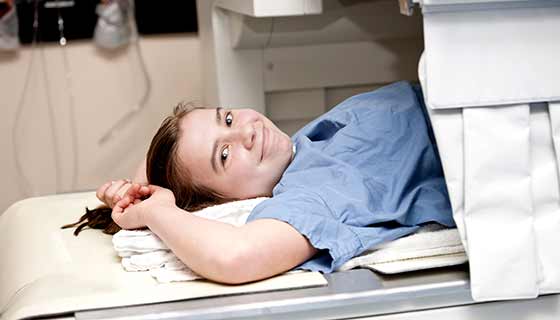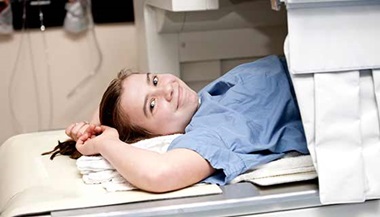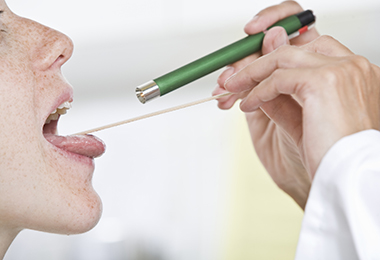Fiberoptic Evaluation of Swallowing
Featured Expert:
What is fiberoptic evaluation of swallowing?
A fiberoptic endoscopic evaluation of swallowing (FEES) test is a procedure used to assess how well you swallow. During the procedure, a speech-language pathologist (SLP) passes a thin, flexible instrument through your nose. Then the SLP views parts of your throat as you swallow.
When you swallow food or liquid, it passes through your mouth and down through parts of your throat called the pharynx and larynx. From here, the food or liquid passes through a long tube (esophagus) before entering your stomach. This movement requires a series of actions from the muscles in these areas. It also requires coordination with the muscles of breathing, since breathing pauses during a swallow.
When you breathe, air passes through your pharynx and larynx, too. It then travels down through a long tube called the trachea before it reaches your lungs. There is a small piece of tissue called the epiglottis that acts like a flap and covers your trachea when you swallow food or drink. This is so food and fluids do not go into your trachea and lungs.
A FEES test can help assess if you are having any problems with the part of the process when food and liquid passes through your throat. A FEES uses a flexible tube called an endoscope. This instrument has a tiny camera and light attached to it. Before the FEES test, you may have something sprayed in your nose to help numb the area, so you do not feel the tube being gently inserted. Your SLP will pass the endoscope through your nose and into your pharynx. It sits above your epiglottis for most of the viewing and then can be moved down after each swallow so the vocal folds may be seen. The endoscope allows your SLP to see parts of your larynx, pharynx and trachea on a video screen.
The FEES test has two basic parts. During the first phase, the structure of the pharynx and larynx may be observed. The SLP will watch how well you swallow saliva prior to any food. The second part of the FEES test is when food is introduced. Here your swallowing will be assessed with different textures and sizes of food and liquid. Your SLP may use food color to dye the food and liquid so it is easier to view on screen. You may need to adopt different positions or try different types of foods as your SLP evaluates your throat and swallowing function.
Why might I need a FEES test?
You may need this test if you have trouble swallowing (dysphagia). With dysphagia, something is wrong with the muscular coordination needed for normal swallowing. Dysphagia can lead to food or fluid going into the airway or lungs (aspiration). This can lead to pneumonia and other problems. Because of this, it’s important to promptly identify and treat your dysphagia if you have it.
A FEES can help your SLP identify what parts of your throat and mouth might not be working well. The FEES can also show if there are certain foods or liquids you need to avoid, or if certain positions can help you swallow more safely. The FEES can also show if you are aspirating.
You might need a FEES if you have any symptoms of dysphagia, such as a sense of food sticking in your throat or pain with swallowing. You also might need a FEES if you have a medical condition that puts you at high risk of dysphagia, even if you don’t have symptoms. Some people with dysphagia don’t have any symptoms. For example, if you have had a stroke, someone may need to check to see if you have dysphagia. This may require getting a FEES test. Other conditions that might cause dysphagia include:
- Head and neck cancer.
- Head injury.
- Conditions that lead to decreased saliva (such as Sjogren’s syndrome).
- Parkinson’s disease or other neurologic conditions.
- Muscular dystrophies.
- Obstruction in the esophagus (such as from cancer).
In many cases, an SLP will first assess your swallowing with some simple tests. You may need to swallow and move your mouth in certain ways. The SLP checks if certain consistencies seem to give you difficulty. Based on the results of this swallowing exam, your SLP may want to schedule a FEES to get more information about the cause of your possible dysphagia.
A similar test is the modified barium swallow study (MBS). This uses fluorosocopy (X-rays) to view your swallowing. One of the advantages of the FEES over the MBS is that the FEES test does not expose you to any radiation. And unlike the MBS, a FEES may be done in an office or clinic, instead of a hospital.
What are the risks of FEES test?
All procedures have some risks. The risks of FEES include:
- Nosebleed.
- Discomfort.
- Gagging or vomiting.
- Brief closure of your airway (laryngospasm).
- Aspiration (usually only a small amount).
The SLP will work to minimize these risks. Your own risks may vary according to your age, your general health and the reason for your procedure. Talk with the SLP to find out what risks may apply to you.
How do I prepare for a FEES test?
Until your FEES test, your SLP may want to put you on a special diet to help prevent aspiration. Only eat and drink what is on the approved list. Do not eat for one hour prior to the procedure. The SLP will instruct you if there is anything else you need to do to prepare.
Tell the medical team about all medications you take. This includes any medication that thins the blood. You may need to stop taking some medications before the procedure. Also tell the medical team if you have had any surgery to your neck, throat or nose.
What happens during a FEES test?
If you are a patient in the hospital, the FEES test may be done in your hospital room or you may go to a doctor’s office or clinic to have the test. Your SLP may do the procedure alone, or with the help of a doctor or nurse.
Your doctor and SLP can give you an idea of what to expect during your test. The procedure usually takes about 20 minutes. Each person’s experience may vary. In general, this is what you can expect:
- During the test, you’ll be seated and awake. An anesthetic will be sprayed in your nose. This is so you don’t feel the endoscope.
- Your SLP quickly inserts the endoscope through your nose and down into your throat (pharynx). You might feel mild discomfort during the procedure. Some people also experience a sense of tightness or a gagging sensation. The anesthetic can minimize this.
- The SLP uses the video screen to see how well you are swallowing and if you are aspirating. Your SLP will look at a number of factors. These include how well secretions are swallowed, how well breathing and swallowing occur together, and how well the airway closes off. He or she will also be able to see if there are any abnormal structural problems.
- You will likely also take small amounts of food or liquid. These will be dyed so they can be seen on the screen.
- At the end of the procedure, the endoscope will be pulled out from your pharynx and nose.
What happens after a FEES test?
In many cases, you will be told the results of your test right away. You might even watch a video of the test. If you had the test done in a doctor’s office or clinic, you will be able to drive yourself home after your exam. You will probably be able to resume your normal activities right away.
If your FEES test shows that you have problems swallowing, the doctor and SLP will work together to develop a treatment plan for you. This may include modifying the types of foods you eat. For example, you may need to avoid liquids of a certain thickness. You may need to make changes in your positioning while you eat. And you may need to learn certain methods for swallowing better.
It’s important to work closely with your medical team. Carefully following their instructions can help you reduce your risk of complications, such as pneumonia from aspiration.
Next steps
Before you agree to the test or the procedure make sure you know:
- The name of the test or procedure.
- The reason you are having the test or procedure.
- What results to expect and what they mean.
- The risks and benefits of the test or procedure.
- What the possible side effects or complications are.
- When and where you are to have the test or procedure.
- Who will do the test or procedure and what that person’s qualifications are.
- What would happen if you did not have the test or procedure.
- Any alternative tests or procedures to think about.
- When and how will you get the results.
- Who to call after the test or procedure if you have questions or problems.
- How much will you have to pay for the test or procedure.
Swallowing Center

The Johns Hopkins Swallowing Center offers specialized swallowing evaluation, diagnosis and treatment for patients with swallowing disorders. Our multi-specialty team includes laryngologists, speech-language pathologists and other specialists, who work together to provide you with personalized and compassionate care.







